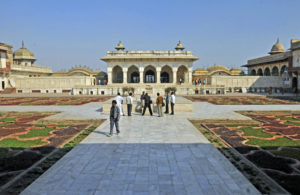
Khas Mahal in Agra Fort (Photo by Don Knebel)
In 1628, Shah Jahan became the fifth Mughal Emperor, controlling much of the Indian subcontinent from his capital in Agra. Soon after assuming the throne, Shah Jahan renovated a walled fort that had been built by his grandfather, Akbar the Great, on a 100-acre site along the west bank of the Yamuna River. Shah Jahan replaced many of the red sandstone structures with more ornate ones made of white marble. He built the lavish Khas Mahal to serve as his sleeping chamber. A short walk from the Khas Mahal he built a jeweled octagonal tower named Musamman Burj as the residence for Mumtaz, the second of his three wives.
The Khas Mahal opened onto a large four-section garden flanked on three sides by a two-story dormitory that served as Shah Jahan’s harem, where female employees and relatives and the emperor’s concubines were housed. Estimates of the number of women in Shah Jahan’ s harem range from 200 to several thousand, guarded by eunuchs and managed by the emperor’s mother. Members of the harem were expected not only to provide sexual favors to Shah Jahan on demand, but to sing and dance for his pleasure. Shah Jahan reportedly also used members of his harem as pawns on a huge Parcheesi board constructed near his chamber, where he moved the pieces while sitting under a canopy.
Despite the many women in his harem, Shah Jahan was devoted to Mumtaz. When she died during the birth of her 14th child in 19 years, he built the Taj Mahal as her tomb, located along the Yamuna River and visible from a room in the Musamman Burj.
Comments are closed.